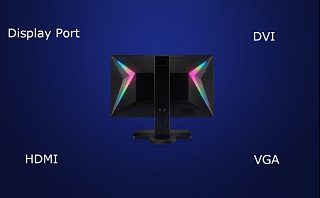Which Monitor Cable Do You Need?
With all the cables standards available, choosing which cable to use can seem a daunting task, especially if you aren’t much familiar with the various types and their features. But don’t worry! Our in-depth review will definitely help and make the choice for you!
Content Outline
VGA
VGA (Video Graphics Connector) is a three-row 15 pin connector. Often accompanied by a pair of thumbscrews, the VGA cable was introduced in the 1980s and soon became the preferred standard – Whether it be bulky computers, laptops, projectors, or video cards, you would always find a VGA port.
What Resolution Does VGA Cable Support?
While the VGA connector is capable of supporting a resolution of 2048x1536p at 85Hz, the signal quality decreases over 1920x1080p owing to the signal’s analog nature, resulting in a drop in image quality. As newer and more efficient cable standards were introduced, the use of VGA cable decreased, and nowadays, you may not find a VGA port on every modern-day display.
What is The Recommended Cable Length For VGA?
Cable length does matter when buying an HDMI cable because longer cable lengths can result in a decrease in signal quality.
VGA cables can work well up to 50 feet (15 meters).
DVI
Introduced in the 1990s, the DVI (Digital Visual Interface) is a cable standard consisting of three types:
- DVI-A (Analog Only)
- DVI-D (Digital Only)
- DVI-I (Digital and Analog)
Despite the shift to better cable standards, DVI-I and DVI-D are still commonly used and supported by graphic cards and displays, especially the budget-friendly monitors. The DVI-A cable, however, is hardly used nowadays.
What Resolution Do DVI Cables Support?
DVI cables are either single-link or dual-link. The single-link DVI-I and DVI-D cables support a resolution of 1920x1200p at 60Hz, whereas the dual-link versions of DVI can run QHD (2560x1440p) resolution at 60Hz. Though, do remember that DVI cables do not possess audio support.
What is The Recommended Cable Length For DVI?
The recommended length for DVI cables is 5 meters, especially if you want to run a 2560 x 1440p resolution.
HDMI
HDMI is a relatively newer technology and has become one of the de-facto cable standards, with the majority of modern-day displays and GPU being equipped with an HDMI port. HDMI consists of:
- HDMI 1.4
- HDMI 2.0
- HDMI 2.1
What Resolutions Do The HDMI Types Support?
HDMI 1.4 supports: 1920 x 1080p (FHD) at 120Hz, 2560 x 1440p (QHD) at 60Hz and 3840 x 2160p (4K) at 30Hz
HDMI 2.0 supports: 1920 x 1080p (FHD) at 240Hz, 2560 x 1440p (QHD) at 144Hz and 3840 x 2160p (4K) at 60Hz
HDMI 2.1 is the most recent and advanced version of the HDMI standard and supports 3840 x 2160p (4K) at 60Hz and 7680 × 4320 (8K) at 30Hz
Which Cable Do You Need For Xbox?
Xbox One X: It requires an HDMI 2.0 to run 4K at 60Hz
Xbox One S: You will need an HDMI 2.0 to run 4K at 60Hz.
Which Cable Do You Need For PlayStation?
PS4 Pro: It requires HDMI 2.0 to run 4K at 60Hz.You can also use an HDMI 1.4 cable, but it will be restricted to displaying 4K at 30Hz.
PS4 and PS4 Slim: An HDMI 1.4 cable will work just fine.
What is The Recommended Cable Length For HDMI?
The recommended cable length for an HDMI cable is about 25 feet (7.6 meters), though there are also boosted HDMI cables, which can exceed 50 feet in length.
If you wish to utilize HDMI cable for 4K, the recommended length is 10 feet (3 meters).
DisplayPort
Alongside HDMI, DisplayPort is one of the leading cable standards. Over the years, different versions of DisplayPort have been released:
- DisplayPort 1.2
- DisplayPort 1.4
- Mini-DisplayPort
What Resolutions Do The DisplayPort Versions Support?
DisplayPort 1.2 supports: 5K resolution at 30Hz, 4K resolution at 75Hz, and 1080p resolution at 240Hz
DisplayPort 1.4 supports: 5K resolution at 60Hz, 4K resolution at 120Hz, and 8K resolution at 30Hz.
DisplayPort 1.4 also supports DSC (Display Stream Compression), making it capable of running 8K at 60Hz.
Mini-DisplayPort is capable of delivering equal bandwidth as its DisplayPort version. This means that mDP 1.2 supports the same resolution as supported by DP 1.2.
What is The Recommended Cable Length For DisplayPort?
DisplayPort cable runs well with lengths under 50 feet (15 meters).
FAQ
DVI vs VGA: Which One Is Better?
DVI cable is better as it is a newer technology than VGA and carries digital signals compared to VGA’s analog, resulting in better overall image quality.
HDMI vs DisplayPort: Which One Is Better?
As far as Image Quality is concerned, there isn’t much to separate the two standards. With the release of newer versions, both HDMI and DisplayPort have increased in their bandwidth and the resolution they support. It is checking the version of the cable, rather than the standard, which you want to use. For example, DisplayPort 1.4 is better than HDMI 2.0 for 4K as DP1.4 supports 4K resolution at 120Hz whereas HDMI 2.0 supports it at 60Hz.
Another thing to consider is the VRR technologies supported. HDMI only supports AMD FreeSync, whereas DisplayPort supports AMD FreeSync as well as NVIDIA G-Sync. So if you have an NVIDIA GPU, DisplayPort will prove a better choice.
DisplayPort also comes with MST (Multi-Stream Transport), which enables you to connect multiple displays using a single cable. HDMI does not have MST support, making DisplayPort a better choice for professionals.
While both HDMI and DisplayPort are widely-used standards, HDMI, unlike DisplayPort, is also the preferred standard for televisions, projectors, and gaming consoles.
Overall, both DisplayPort and HDMI are almost equally good standards and you should choose the standard which will enable you to utilize the features you want.

